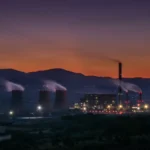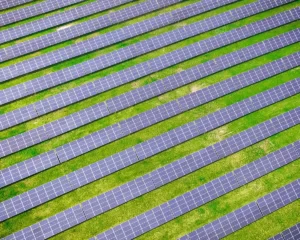Thermal energy, often equated with heat energy, occupies a central position in the vast expanse of natural phenomena and the intricate design of engineered systems. A fundamental question in the field of thermodynamics revolves around whether thermal energy leans more towards potential or kinetic energy.
This distinction isn’t just academic. It’s pivotal for a deep theoretical comprehension and for the practical deployment of thermodynamic concepts. Let’s embark on an exploration to decode the true nature of thermal energy.
However, the story doesn’t end here. Thermal energy also has a relationship with potential energy, particularly in the form of intermolecular forces.
When particles move closer or further apart, the potential energy within the system changes, influenced by these forces. In solids, for instance, the vibrational energy of atoms while primarily kinetic also involves shifts in potential energy as atoms oscillate around their equilibrium positions.
So, is thermal energy potential or kinetic? The answer is not a simple binary. Thermal energy represents a dynamic equilibrium between kinetic and potential energy within a system.
In a Nutshell
- Thermal energy arises from the kinetic energy of microscopic particles and is therefore a form of kinetic energy at the atomic level.
- However, thermal energy can be viewed as potential energy at the macroscopic scale, as it represents the potential to do work in a thermodynamic system.
- Thermal energy is transferred between objects through convection, conduction, and radiation, pointing to its kinetic origins.
- Both the potential and kinetic aspects are vital to analyzing heat transfer and thermodynamic processes.
In gases, the kinetic aspect dominates due to the rapid movement of particles. In contrast, in solids and liquids, the interplay between kinetic and potential energy becomes more pronounced due to the significant influence of intermolecular forces.
The Kinetic Nature of Thermal Energy
At the heart of thermal energy lies the kinetic energy of atoms and molecules. This energy manifests through their rapid vibrations, rotations, and translations. As these particles engage in random microscopic motions, they transfer kinetic energy across materials, manifesting as heat. The principle here is straightforward: the faster the molecular motion, the greater the thermal energy.
In solids, thermal energy equates to the total kinetic energy of atoms oscillating within their lattice positions. Meanwhile, in liquids and gases, it arises from the translational, rotational, and vibrational kinetic energy of freely moving molecules. The crux of the matter is that heat is essentially the cumulative kinetic energy of distinct particles.
Heat is a mode of motion, an oscillation or vibration of the atoms and molecules of which matter is composed.
Rudolf Clausius
The mechanisms of thermal energy transfer underscore its kinetic origins. Conduction is about direct molecular collisions. Convection hinges on the bulk movement of materials and radiation involves photons that carry momentum and energy. Each of these processes necessitates some degree of particle motion.
Moreover, elevating an object’s temperature accelerates its atoms and molecules, thereby infusing kinetic energy. This intrinsic link between microscopic motion and thermal energy underscores the notion that heat is fundamentally kinetic.
Microscopic Kinetic Energy: The Building Blocks
- Atomic vibrations, rotations, and translations
- Molecular collisions and flows
- Particle speeds and their direct correlation with temperature
Transfer Mechanisms: The Pathways of Heat
- Conduction: Particle collisions
- Convection: Material flows
- Radiation: Photon dynamics
This microscopic perspective firmly positions thermal energy within the kinetic domain. However, this kinetic paradigm prompts a compelling inquiry: How does this view integrate with the potential energy perspective of heat?
Thermal Energy as Macroscopic Potential
While the kinetic energy of atoms and molecules lays the groundwork for thermal phenomena, thermal energy can also be conceptualized as a form of potential energy within thermodynamic systems. This macroscopic outlook zeroes in on the aggregate energy within a system and its capacity to do work.
From this angle, thermal energy symbolizes the potential to spark changes, propel processes, and execute work by migrating between objects at varying temperatures. It represents the reservoir of energy poised for utilization through heat transfer mechanisms.
Consider the operation of a steam engine, where the thermal energy of high pressure steam has the potential to move a piston and accomplish work. As the steam expands and cools, this potential is tapped into. The engine’s ability to generate work hinges on exploiting a thermal gradient.
This concept extends further: temperatures amplify the potential for work, integrating temperature as a multiplier in thermodynamic equations. This underlines the potential energy aspect of heat in macroscopic phenomena.
Macroscopic Potential: A Closer Look
- Total thermal energy at one’s disposal
- Capacity to perform work: The crux of potential energy
- Driving force: Stemming from thermal gradients
- Dependent on heat transfer and temperature: The bedrock of thermodynamic processes
In essence, thermal energy straddles the realms of kinetic and potential energy. At the microscopic level, it’s a kinetic phenomenon, rooted in the motions of atoms and molecules. Conversely, at a macroscopic scale, it assumes the role of potential energy, with its capacity to drive work and propel thermodynamic processes.
This bifocal perspective not only enriches our understanding of thermal energy but also broadens the spectrum of its applications, from engineering marvels like steam engines to the theoretical constructs of thermodynamics.
Resolving the Debate: Is Thermal Energy Potential or Kinetic?
The journey to decipher whether thermal energy is more aligned with potential or kinetic principles culminates in an understanding of the kinetic potential duality. This duality does not pose a question of either/or but rather illustrates a context dependent relationship.
At the Microscopic Level: A Kinetic Domain
When exploring thermal energy at the atomic or microscopic scale, the question of “is thermal energy potential or kinetic?” finds its answer in kinetics. Here, the energy is unequivocally kinetic, driven by the motion of atoms and molecules. These movements, whether they are vibrations, rotations, or translations, define thermal energy as a kinetic phenomenon at this level.
At the Macroscopic Scale: The Potential Perspective
Shifting the focus to macroscopic systems, the narrative changes. In these broader contexts, thermal energy embodies potential energy. This shift from kinetic to potential energy models heat transfer in larger systems effectively. It’s here that the potential energy of heat, much like gravitational potential, emerges from the collective kinetics of particles.
Bridging the Gap: Kinetic Potential Duality
This brings us full circle in our exploration of “is thermal energy potential or kinetic?” Recognizing the application of kinetic theory at the microscopic level and potential energy concepts at the macroscopic level reconciles the apparent disparity. This duality is not contradictory but complementary, with the choice of perspective depending on the scale and objective of the analysis.
- Microscopic Analysis: Kinetic energy reigns, showcasing thermal energy as a function of particle movement.
- Macroscopic Analysis: Thermal energy transitions to potential energy, highlighting its capacity to perform work and drive processes.
- Unified Understanding: The kinetic potential duality enriches our comprehension, allowing for a flexible framework in thermodynamics.
This nuanced understanding underscores that thermal energy seamlessly spans the realms of both kinetic and potential energy. Whether analyzing the chaotic dance of particles or the grand orchestration of macroscopic processes, thermal energy’s dual nature offers a versatile lens through which we can examine thermal phenomena.
Harnessing the Kinetic Potential Duality: Broadening Horizons in Science and Engineering
The exploration of whether thermal energy is potential or kinetic culminates in tangible applications that underscore the value of this duality across various scientific and engineering disciplines. The kinetic theory, particularly, is indispensable in areas such as statistical mechanics and nanoscale engineering, where the focus is on atomic motions and the nuances of microscopic heat transfer.
For those designing microchips or delving into the physics of phonon conduction, a kinetic perspective is not just beneficial: it’s essential.
On the other side of the spectrum, the concept of potential energy plays a pivotal role in analyzing and optimizing large scale systems. This includes power plants, combustion engines, and complex chemical processes.
Engineers can improve heat engines and make accurate models of industrial thermodynamic cycles by using macroscopic thermal potentials. This shows how thermal energy can be used in real life when seen as potential energy.
Bridging Disciplines with the Kinetic Potential Duality
- Micro and Nanoscale Systems: Kinetic models are crucial for understanding and controlling phenomena like chip heating or phonon conduction at the nanoscale.
- Macroscale Processes: Potential energy methods offer a framework for optimizing and analyzing large scale engineering systems, from power generation to industrial manufacturing.
- Cross Disciplinary Collaboration: Recognizing the duality of thermal energy fosters a unified approach to thermal physics, enhancing collaboration, idea exchange, and theoretical integration across disciplines.
Embracing the duality of thermal energy as both kinetic and potential not only deepens our theoretical understanding but also expands our practical capabilities in thermal engineering and physics. This comprehensive grasp of thermal energy’s nature facilitates innovations and efficiencies in technology and industrial processes, demonstrating the profound impact of the kinetic potential duality on advancing human knowledge and application.
Exploring the Frontiers: Unresolved Mysteries and Future Directions in Thermal Physics
Despite significant advancements, the realm of thermal physics, guided by the dual framework of kinetic and potential energy, continues to harbor unresolved questions and vast potential for discovery. These open questions not only challenge our current understanding but also pave the way for future innovations. Among these inquiries are:
- Efficiency in Scaling: How can we effectively upscale microscopic kinetic simulations to encompass broader, more complex systems?
- Complex Systems Modeling: Is there a need for new potential energy models to accurately represent the dynamics within complex multi phase systems?
- Hybrid Methodologies: Can innovative hybrid methods be developed to seamlessly couple kinetic and potential frameworks, offering a more holistic view of thermal energy dynamics?
These questions underscore the ongoing quest for deeper insights and more effective tools in thermal physics. Moreover, the field is witnessing a renaissance in experimental techniques aimed at dissecting heat transfer mechanics and understanding thermal behavior in emerging materials.
Innovations Driving the Field
New technologies, such as solar thermophotovoltaics, stand at the vanguard of thermal physics, melding the kinetics of thermal radiation with the potential energy of electrical systems. These innovations are not just expanding the boundaries of what’s possible. They are redefining the intersection of the thermal and electrical energy domains.
Theoretical and Technological Progress: A Dual Thrust
The interplay between theoretical exploration and technological advancement continues to fuel the dynamism within thermal physics. The pursuit of answers to the field’s lingering questions fosters a vibrant research environment that is both challenging and enriching. As researchers delve into the mysteries of thermal energy, from scaling kinetic models to integrating new potential energy frameworks, the potential for groundbreaking discoveries and applications looms large.
- Microscopic Kinetics to Macroscopic Applications: Bridging this gap remains a crucial challenge, inviting innovative solutions and interdisciplinary approaches.
- Complex Systems and Multi Phase Dynamics: Addressing the intricacies of these systems may require novel theoretical models and experimental methodologies.
- Hybrid Approaches: The potential for hybrid models that blend kinetic and potential energy perspectives promises a more comprehensive understanding of thermal phenomena.
In summary, the field of thermal physics, with its foundation in the duality of thermal energy as both kinetic and potential, remains a fertile ground for exploration and innovation. Theoretical advancements and technological breakthroughs continue to drive the discipline forward, highlighting the enduring significance and vibrant future of thermal physics.
Wrap Up
In essence, thermal energy transcends the conventional dichotomy between kinetic and potential energy, showcasing a remarkable duality that serves as the cornerstone for understanding heat transfer across various scales and disciplines.
At the microscopic level, the kinetic origins of thermal energy are unmistakable, rooted in the ceaseless motion of atoms and molecules. This kinetic perspective is instrumental in dissecting and modeling phenomena within realms as minute as nanotechnology, where precise control over thermal properties is paramount.
Conversely, on the macroscopic scale, thermal energy manifests predominantly as potential energy. This perspective is crucial for the analysis and optimization of large scale systems, such as power plants and combustion engines, where the focus shifts towards harnessing thermal gradients to perform work and drive processes.
Bridging the gap between these two perspectives, the field of thermal physics provides a coherent and versatile framework for modeling heat transfer. This duality not only enriches our theoretical understanding but also amplifies the practical applications of thermal energy.
From the intricacies of nanoscale engineering to the grandeur of industrial power generation, adopting either a kinetic or potential viewpoint or sometimes a hybrid of both enables tailored solutions and optimizations.
As the frontier of research continues to expand, the journey of discovery promises not only to refine our comprehension of thermal energy but also to catalyze transformative innovations. Whether it’s through advancing experimental methods, exploring novel materials, or developing groundbreaking technologies like solar thermophotovoltaics, the future of thermal physics is vibrant with potential.
Thus, the exploration of “is thermal energy potential or kinetic?” leads us to a profound appreciation for the complexity and ubiquity of thermal energy. As our understanding deepens and our methodologies evolve, the unified framework of thermal physics stands poised to address the challenges of the present while unlocking the innovations of tomorrow.
FAQs

Heat is the total energy transferred between objects, while temperature is a measure of the average kinetic energy of particles in a substance. Temperature indicates how hot something is, while heat refers to the transfer of thermal energy.
Heat tends to rise due to convection, as warmer, less dense substances have a tendency to rise relative to cooler denser ones. However, heat can transfer downwards through conduction.
The three modes of heat transfer are conduction, convection, and radiation. Conduction is direct transfer through matter, convection involves heat transport via mass motion, and radiation works through electromagnetic waves.
Adding thermal energy increases the speed/kinetic energy of particles in the system. This manifests as a rise in temperature. At the macroscale it provides more potential energy to perform work.
The kinetic theory states that gas pressure arises from particles colliding with containers and the temperature relates to the average kinetic energy of gas particles.
It uses the Seebeck effect, where passing heat across a junction of different metals produces voltage, to convert heat differentials directly into electrical power.
No heat engine converting heat to work can exceed the maximum Carnot efficiency, defined as 1 – (cold temperature/hot temperature). It limits the fraction of heat convertible to useful work.
Article sources
At Capital Maniacs, we are committed to providing accurate and reliable information on a wide range of financial topics. In order to achieve this, we rely on the use of primary sources and corroborated secondary sources to support the content of our articles.
Primary sources, such as financial statements and government reports, provide firsthand evidence of financial events and trends. By using primary sources, we are able to directly reference information provided by the organizations and individuals involved in these events.
Secondary sources, such as financial analysis and commentary, interpret and analyze primary sources. While these sources can be useful for providing context and background information, it is important to use corroborated sources in order to ensure the accuracy and reliability of the information we present.
We take pride in properly citing all of our sources, both primary and secondary, in order to give credit to the original authors and to allow our readers to verify the information for themselves. We appreciate your trust in our website and are committed to upholding the highest standards of financial journalism.
- Justenergy – Potential and Kinetic Energy Explained
- Eia.gov – Forms of energy – Energy Kids: U.S. Energy Information
- Van.physics.illinois.edu – Heat Energy – Kinetic? Or Potential?
- Physics.stackexchange – newtonian mechanics – Potential, Kinetic, Thermal Energy
- Houstonisd.org – Thermal Energy
- Khanacademy.org – Types of energy
- En.wikipedia.org – Thermal energy
























